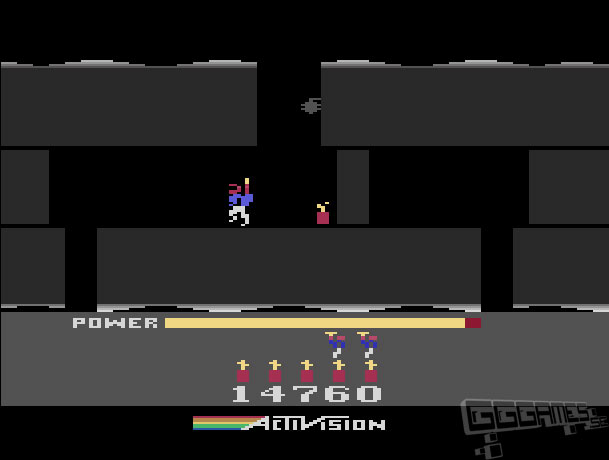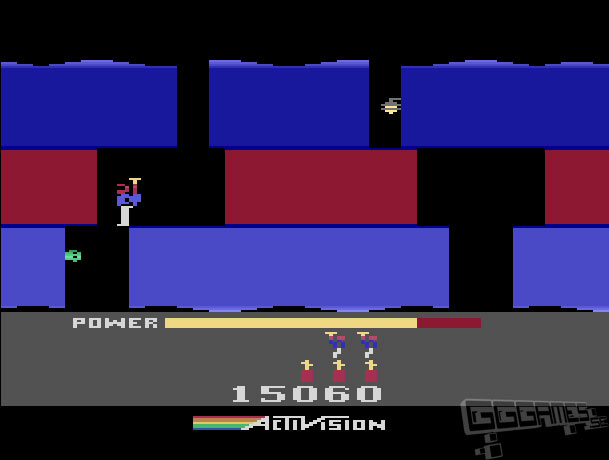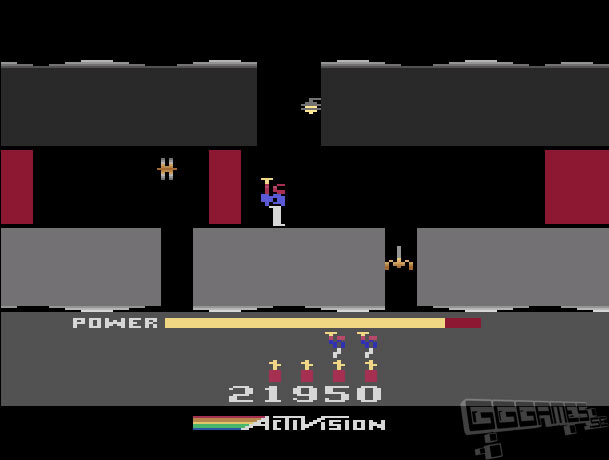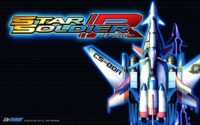H.E.R.O. Review
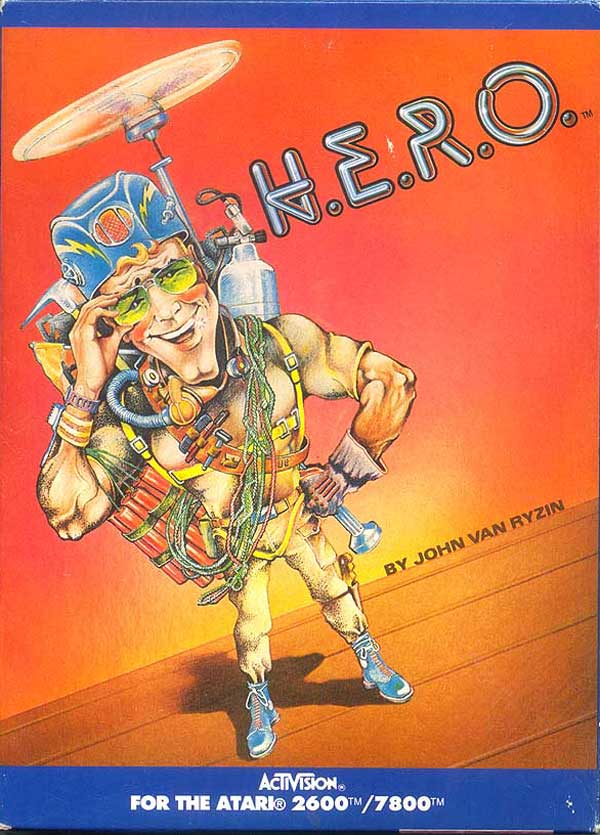
Somewhat addicting but also stressful and baffling action platform game.
Story
Volcanic activity has trapped miners in deep mine shafts in Mount Leone and Roderick Hero comes to the rescue. Equipping his own crafty inventions, he is the only only one who can help the miners before their time runs out. The mine shafts are crawling with all sorts of deadly vermin making the rescue work a dangerous undertaking for Mr. Hero.
The Game
H.E.R.O. is a stressful action platform game where you blast dangerous vermin and blow up walls on your way to rescue trapped miners. You play as the makeshift rescuer Roderick Hero equipped with a propeller powered backpack flying device, some dynamites and a helmet-mounted laser cannon. You descend down the many mine shafts and the trapped miner you are to rescue is found at the bottom level of each stage. Once you rescue a miner, you are taken to the next stage, so your ultimate goal is simply to rescue all the miners. The game has a strict time limit which forces you to keep moving no matter what, and the further you go the more forbidding hazards you’ll meet in the form difficult environments and how enemies are placed.
Controls
This is a game that demands high precision controls. Yet the entire flying mechanic is very tricky to figure out. Holding the joystick upwards for a brief moment will take you off into the air. There are several occasions in the game when you must be able to time your take off with a high level of accuracy in order to avoid dangers. This feels very unreliable at first, but you’ll eventually work it out. Needless to say, it will cost your life a bunch of times as well. You can also use your propeller backpack to hover in mid air, which also requires some well timed pulls of the joystick – if you pull too little you’ll start falling down. If you pull too much, you’ll rise higher than intended. It all happens so fast that you must rely on experience rather than reaction.
Placing dynamites is done by a simple downward pull of the joystick. Because of this, you will most certainly place a few unintentionally while learning how to play the game.
Content
Before the game begins you can select one of five game variations. This decides which stage you’ll start your game on. The very first few stages are obviously very easy and you could regard them as simple tutorial levels. But the difficulty level picks up quickly from there, introducing new dangers as you go. The game has 20 stages all in all and an extra “pro-mode” once you’ve beaten all 20 stages. Also, the fifth game variation is a special endless mode in which the order of levels is randomized.
You’re given four lives to beat the game. Scoring high points will earn you extra lives, but the average difficulty level is insanely high, and sometimes even unfair. Roderick is very vulnerable, so anything dangerous that he comes in contact with kills him instantly.
On your daring rescue mission you’ll encounter many types of problems. Bats and spiders are, perhaps the most direct threat. They’ll lurk around quite passively but often exactly where you have to go. Blasting them with the laser cannon is usually not a problem but the real threat about these enemies are that they tend to surprise you. Because the game has no scrolling you can’t see what’s on the next screen before you enter it. This is how many of the hazards in the game will catch you off guard. It is obvious how memorizing each screen will increase your chance of survival, but it is a bit off putting having to rely on it so much. It’s almost as if the entire game is based around it.
Other than the bats and spiders, you need to keep an eye out of environmental hazards such as water and magma. There are moving magma walls that you must try to squeeze your way through, and water filled sections where you must rely on your flying skills.
There are also plenty of caved in passages, which effectively block your way. This is where your dynamites come in handy. Since your dynamite stock is limited, you need to be mindful of which walls you blow up. Caved in passages can also be shot down with the laser cannon, but it takes a considerable amount of time.
There are numerous lamps hanging throughout the mines. If you get close to them, they go out, leaving the screen pitch black. Enemies will still be seen though, so you have a fair chance of knowing what’s going on even with the lights out. Placing a dynamite will light up the screen for a brief moment, so you will have a chance to catch up with the surroundings every time you blow up a wall in the dark. The lamps are often located inconveniently on purpose so that you can’t avoid touching them. It’s just something you have to be prepared for on top of all other difficulties you’re presented with.
The way levels are laid out gets a little repetitive after a few stages. You’ll see the same kind of rooms numerous times throughout the game, but there are some things in there to keep it fresh. There are often two or three possible exits from each room, and sometimes you even have to go around obstacles that span across two screens. The level design is linear though, so if there are multiple exits, they all go into the same room. When ever you see multiple exits from a room, you’ll see that the least accessible exit is always the best one to take. There isn’t any logic to this other than that the developers wanted to reward players who go that extra mile.
The sprite collision is a little bit too stringy. There are rare occasions when you’ll die from an enemy even though you clearly didn’t touch it.
On a brighter note, despite the high difficulty level, the challenges never feel impossible. The game is fun enough to keep you playing for a good while, and it’s easy to get caught in it and just keep retrying. Thanks to the different game variations you can sort of pick up where you died – a very clever and nice feature.
Graphics
The graphics are simple, but still have some interesting features such as water animations and that you’ll be able to tell the depth of the mine from the colors of the walls. Also the darkness that follows when a lamp goes out is quite well done considering the Atari 2600’s limitations.
The animations are well done too – you’ll see Roderick run, his propeller backpack spin, bats flap their wings and even the sparks from dynamite fuses.
When Roderick dies, he’ll turn to you as if he’s accusing you of his death. There’s some comical relief in that for sure.
Sound
The game has no music but instead relies on sound effects. Your laser cannon emits a high pitch noise and your propeller backpack sounds like a chopper. When the dynamites go off, you’ll hear a satisfying early video game “BOOM!”. The tinkling sound that’s played when dying doesn’t make much sense, but is memorable none the less.
Even though the laser cannon sound is a bit too much to endure, the sounds in the game are acceptable. It’s a good fit, even though it certainly could have been better.
Summary
H.E.R.O. is a hard game, but in many ways it has a timeless design. It mixes action and platforming elements in a nice way and lets players experiment with dynamites and a flying device. The game almost requires you to memorize each stage, because otherwise you won’t have time to react to all the traps and hazards that are out there.
Many would agree that this is one of the better games on the Atari 2600. It is very fun to pick up and play, but mastering it demands a special kind of gamer – a hardcore gamer who has enough time to spend to learn the game by heart.



